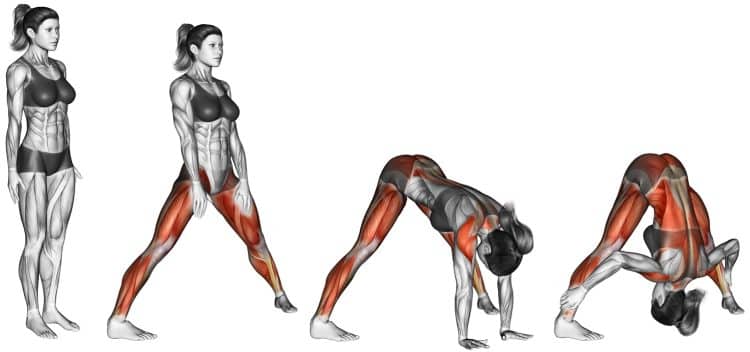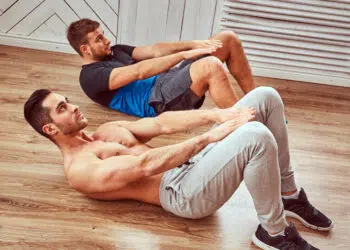One of yoga’s many fold poses, the sangskrit name prasarita padottanasana describes five elements of the wide legged forward bend:
- “Prasarita” – Spread
- “Pada” – Foot/leg
- “Ut” – Intense
- “Tan” – To stretch
- “Asana” – Pose
Putting the sequence into action, the yogi takes a wide, straddle stance which requires foot and thigh strength, hip flexibility, and core strength. Moving up the chain, the hips hinge the upper body forward, until the torso is inverted or folded over, and the head is upside down.
Wide legged forward fold is a common yoga pose, and it benefits everything from the feet (strengthening), to the head (increased blood flow to the brain which may yield some benefits).
In this guide, we detail how to perform this pose, with a short video demonstration, tips, common mistakes to avoid, and some arm variations.
Muscles Worked During Wide Legged Forward Bend
While wide legged forward bend isn’t working muscles to increase their strength and size (primarily although you may get a little of that), you can expect a phenomenal stretch, and to recruit muscles in a way they’re not usually.
Level Up Your Fitness: Join our 💪 strong community in Fitness Volt Newsletter. Get daily inspiration, expert-backed workouts, nutrition tips, the latest in strength sports, and the support you need to reach your goals. Subscribe for free!
Hamstrings
The most obvious muscles stretched during a forward bend are the hamstrings. On the back part of your upper leg strung between the hips and thighs, most ham stretches involve hinging the hips forward, to really lengthen the three sections of fibers that make up this muscle group.
Your hamstrings are athletic muscles, that can help us to perform explosive movements, acting as a rubber band being stretched, and released. They’re also key to the gait or walking cycle.
Glutes
Butt muscles that form a large portion of the hips, you have a large maximus, smaller medius, and smallest minimus muscle in your backside. Maximus is the largest, strongest, and most notable, creating most of what is your hips size and shape. Consequently, the role of maximus is controlling movements at the hip such as extension, and external rotation of the thigh.
Abdominal core muscles
You may not realize it, but when you hinge forward at the hips, and stand back up after the wide legged forward bend, your core muscles have to step into decelerate the descent, and extend the spine, respectively. It’s your deeper core muscles, transverse abdominis that stabilize the spine, while the erector spinae muscles by the spine, stand you up from a bent over position.
How To Do Wide Legged Forward Bend
Considered a beginner yoga pose, for many who attempt it for the first time, there’s nothing beginner about it. But the key is having the right setup, being patient, listening to your body, and keeping at it.
Before you thrust yourself into the wide legged forward bend, we recommend checking out the short video demonstration below, and using the written instructions below for reference and tips.
Steps
Note: The first four steps are to prepare your body for the full movement.
- Choose a surface where your feet will not slide.
- From a standing position, spread your feet apart into a wide stance, creating roughly 4-5 feet of space in between. You want a wide stance but not so wide that you lose stability and balance.
- Point your toes forward or slightly inward to activate the inner thighs and glutes, keep your legs straight and engaged, and focus your weight on your outer feet. Place your hands on your hips.
- Now hinge forward at the hips, and lower your torso until your upper body is roughly parallel to the floor. Make sure to keep your back straight. Then, slowly stand up straight.
- Repeat step 4, but now stretch your arms down to the floor and touch it with your fingertips.
- Walk your hands back until your fingers and toes are in line, and press your palms flat on the floor.
- Lift your head up and gently stretch toward the sky.
- Then drop your head and body down toward the floor, while bending your elbows. Try to relax your upper body.
- Gently rest the crown of your head on the floor. Hold this position for a few seconds, trying not to exceed 10 seconds at first.
- Now come up onto your fingers, walk your hands forward, and bring your hands on your hips, one at time, then slowly stand up in the starting position.
Tips
- Make sure to perform this pose on an appropriate, non-slip surface, such as a yoga mat. Do not try it using socks on a slick floor, as it’s very difficult, and is not good for the groin, and knees.
- If you’re not ready to rest your head on the floor in the full wide legged forward bend pose, then simply use your arms to keep your head up, and practice being in this position.
- If your head touches the floor too easily, narrow your stance a little.
- You can bend your knees slightly if you have tight hamstrings.
- Do not try to rush the process. The body usually takes time to open up so that you can move into deeper positions.
- You can also use yoga blocks under your hands to help decrease the range of motion, if you can’t reach the floor just yet, or if its uncomfortable.
This Exercise
- Target Muscle Group: Hamstrings, glutes, core
- Type: Yoga
- Mechanics: Isolation
- Equipment: Yoga mat
- Difficulty: Intermediate
Benefits of Wide Legged Forward Bend
There are the most obvious and then there are some of the not so obvious benefits of folding yoga poses. Let’s see what they are…
Target your thigh and adductor muscles
One of the poses that involves a forward hip hinge, wide legged forward bend favors a hamstrings and adductors stretch. If you play sports or are regularly involved in resistance training or other activities, it’ll benefit you to keep these muscles loose and active. You’ll also help prevent injuries, and the hamstrings are so important for mobility.
Stretch the neck, back and shoulders too!
We hold lots of tension in our necks, shoulders, and backs, especially being slumped over in front of our devices for most hours of the day. Stretching is helping to reduce the long term negative effects of muscle tightness from prolonged inactivity.
Potential benefits of inverted position
It’s important to note that evidence for the potential benefits of inversion training are not conclusive.
However, hanging upside down does create changes in blood flow which may enhance circulation to the brain. Many believe this can enhance cognitive performance. Inversion type training does decompress the spine though, which is said to create more space between the vertebra, allowing better disk hydration and hence greater spine mobility and reduced risk of injury.
Level Up Your Fitness: Join our 💪 strong community in Fitness Volt Newsletter. Get daily inspiration, expert-backed workouts, nutrition tips, the latest in strength sports, and the support you need to reach your goals. Subscribe for free!
The advantages may extend further though, reaching as deep as the lymphatic system, possibly helping to drain the body of toxins. This process is said to only be able to occur via the movement of muscles, and breathing.
Build patience and mental fortitude
One of the most valuable tools in life is patience. The rewarding things require patience, and mental grit. Wide legged forward bend isn’t just picking up a dumbbell and doing a barbell curl, or sitting down in a squat or performing a push-up.
It requires a bit of many things to be able to maintain a wide stance, bend forward, and set your head on the floor. And for many, it won’t be possible the first few attempts.
Common Mistakes During Wide Legged Forward Bend
Here are some common mistakes that may make for a frustrating or painful experience attempting the wide legged forward bend.
Not spreading your feet wide enough
While it is called the forward fold, most people are not contortionists and will need to spread their feet wide enough to reach their head to the ground. Two to three and even four foot of distance between your feet won’t cut it for most. It’s perfectly normal to have a very wide stance, that way you can decrease the distance your head needs to travel.
But… if you’re just starting out, you could assume a narrower stance, and it’s fine if the head cannot yet touch the floor. Give your hips time to open up and then you can get lower and lower.
Forcing yourself into the pose
Forcing the body to do something is hardly ever recommended. In this case, you can pull tight muscles, or increase risk of injuries in the future.
A common and wise piece of yoga advice is to take it slow, and allow your body to open up when it’s ready. That’s why you’ll typically see professionals perform warmup steps before attempting the full pose. With that said, this pose requires decent flexibility.
Variations of Wide Legged Forward Bend
While the basic wide legged forward bend is a phenomenal practice to get into, here are some fun variations to try and challenge yourself while getting additional benefits.
Wide legged forward bend with hands behind your back
It’ll require more balance, and core control, but it’s just one progression that’ll prove you’re ready for something more challenging. Most people should be able to easily reach behind their body and interlock their fingers. It’ll give you a sweet stretch in the delts too!
Steps
- Get into a wide stance as explained in the original instructions.
- Bring your arms behind your body and interlock your fingers with the palms facing each other.
- Slowly drop your torso under control, and then gently rest your head on the floor. If you cannot yet, place an object such as a yoga block between your feet to rest your head on and reduce the range of motion.
Grabbing your toes
For this variation, you’ll grab your big toes with your pointer fingers on each side as you’re dropping into the folded position resting on your head.
Steps
- In your straddle stance, hinge forward at the hips, and hook your pointer fingers over and around your big toes.
- Keep your elbows bent, pointed up, and try to squeeze your shoulders blades together. Hold this position for the desired time.
With rotation
Like wringing out a wet rag, including a twist in the forward bend will stretch out your oblique muscles that help us to rotate, and bend laterally. It’s also a good technique to help maintain coordination and mobility in the upper body.
Steps
- From a bent over position, extend one arm toward the floor and place your palm flat directly in the center between your feet.
- Now rotate your torso in the opposite direction of your arm, and reach the free arm straight up toward the sky with the fingers straight.
- Now bring the top arm down and switch positions with the other arm, placing your arm in the exact same spot. Then reach up in the opposite direction with the free arm. Repeat for 3-5 repetitions.
Holding the opposite leg
Challenge flexible endurance and stretch your torso by gripping the opposite leg and holding for a static count.
Steps
- From the forward fold position, grab your right ankle with your left hand, and bend the right arm behind your lower back. Breathe in, and then breath out as you release and change sides.
- Now grab the left ankle with the right hand, and place your left arm behind your back. Hold, and repeat by alternating sides.
Seated forward bend pose
Otherwise called Paschimottanasana, the seated forward fold pose trains a similar technique but with the inversion.
Steps
- Sit on the floor with your legs stretched out in front of you. Sit up tall, and pull your toes in toward you.
- Inhale, and reach both arms overhead, then exhale and bend forward at the hips.
- Reach toward your toes. Stop where you’re able too. If you’re flexible enough, grab one wrist with the other hand and your arms in front of the bottom of your feet.
- If you’re flexibility allows, lie face down on your your shins.
- Unlock your grip, and with both arms extended past your feet, inhale and sit up to the original position.
- Exhale and lower the arms.
- That’s the seated forward bend yoga pose.
Here’s a progression technique that you can do if you cannot perform the full pose yet. Use a strap of some type to wrap around the balls of your feet, and slowly try to stretch forward, grabbing the straps closer to your feet as you reach forward.
Wrapping Up
While yoga should incorporate various elements of mental and physical fitness, the wide legged forward bend is a swift and much needed change up from your usual exercises. Combining inversion, stretch, and strength, it’s a pose you should hang-up for the next day and bring it out because of the range of benefits it offers.
Interested in measuring your progress? Check out our strength standards for Barbell Curl, Squat.









